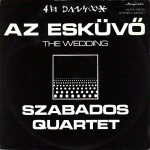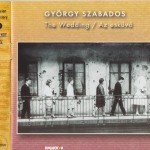– COMPOSITIONS –
 Szabó Irma vallatása
Szabó Irma vallatása
 The Interragation Of Irma Szabó
The Interragation Of Irma Szabó
 Irma Szabó’s Verhör
Irma Szabó’s Verhör
Year of writing:
First known performance:
May 20 – 25, 1974
Year of publishing:
1975
Music Publisher:
Hungaroton / Pepita SLPX 17475
Note:
The Interrogation of Irma Szabo, reveals that the seemingly free improvisatory work is always elaborated by the ensemble as set into some kind of dramaturgically determined structural framework. In The Wedding this was based upon the scheme: Theme I – Theme II – Theme I/a, while here the basis is an individually treated, still living Transylvanian folksong – the ballad of the Questioning of Irma Szabo, an infanticidal mother – (Theme I + Theme I/a – Theme I/b), and this is expounded by the common improvisation, with a free and expressive passion. The impulse of the improvisation is particularly intensified by the violin, with its tone breaking out of torment, with the force of a confession and recalling Webern’s atonality, and its agonized, oriental double-stops.
A Szabó Irma vallatásá-ból kitűnik, hogy a különben szabadnak ható improvizációs munka az együttesnél mindig valamilyen szerkezeti keretbe foglaltan kerekedik egésszé, és dramaturgiailag meghatározott. Az Esküvő-nél ez: a Tema I — Tema II — Tema I/a vázon nyugodott, itt viszont egy sajátosan kezelt, még élő erdélyi népdal —Szabó Irma, egy gyermekgyilkos anya megvallatásának balladája — az alap (Tema I + Tema I/a — Tema I/b) és a közös improvizáció ezt fejti ki szabad és expresszív indulattal. Különösen a hegedű fokozza fel az improvizáció erejét, kínokból felszakadó, vallomásos erejű, a weberni atonalitást idéző hangjaival, gyötrődő keleties kettősfogásaival.
Beim Verhör der Irma Szabó (Szabó Irma vallatása / Interrogation of Irma Szabó) wird es deutlich, dass beim Ensemble die sonst frei wirkende Improvisationsarbeit immer in irgendeinen strukturellen Rahmen gefasst zu einem Ganzen abgerundet wird und sie dramaturgisch bestimmt ist. Bei Der Hochzeit beruht dies auf der Struktur Thema I – Thema II – Thema I/a, hier jedoch ist die Grundlage eine eigenartig gehandhabtes, lebendes Volkslied aus Siebenbürgen – die Ballade über das Verhör der Irma Szabó, einer Kindsmörderin Mutter – (Thema I + Thema I/a – Thema I/b) und die gemeinsame Improvisation entfaltet dies mit freier und expressiver Ergriffenheit. Es ist vor allem die Geige, die die Kraft der Improvisation steigert, mit ihren aus Qualen herausgerissenen, bekenntnishaften, die webernsche Atonalität heraufbeschwörenden Klängen, mit selbstquälerischen orientalischen Doppelgriffen.
LIST OF RELEASES:

![]()
![]()
![]() 1974: Az esküvő (The Wedding)
1974: Az esküvő (The Wedding)
Recordings:
Recording Date: May, 20 – 25, 1974
Recorded at: Hungaroton Studio, Budapest / Time 11:40
Musicians:
![]() György Szabados Quartet
György Szabados Quartet
Szabados György (piano)
![]() Vajda Sándor (bass)
Vajda Sándor (bass)
![]() Kőszegi Imre (drums)
Kőszegi Imre (drums)
![]() Kathy-Horváth Lajos jr. (violin, bass)
Kathy-Horváth Lajos jr. (violin, bass)

![]()
![]()
![]() 1964; 1974; 1981; 1982: Hungarian Jazz History 8 – György Szabados
1964; 1974; 1981; 1982: Hungarian Jazz History 8 – György Szabados
Recordings:
Recording Date: May, 20 – 25, 1974
Recorded at: Hungaroton Studio, Budapest / Time 11:44
Musicians:
![]() György Szabados Quartet
György Szabados Quartet
Szabados György (piano)
![]() Vajda Sándor (bass)
Vajda Sándor (bass)
![]() Kőszegi Imre (drums)
Kőszegi Imre (drums)
![]() Kathy-Horváth Lajos jr. (violin, bass)
Kathy-Horváth Lajos jr. (violin, bass)
PLAYLIST:
read more infos about playlist: #1: 9:25 Musicians: Related items: #2: 21:25 Musicians Related items: #3: 13:32 Musicians Related items: #4: 5:47 Musicician Related items: #5: 13:39 togehter with composition: Ceauswitzi koncert (Ceauswitz concert) Musician Related items:
Recording Date: May, 20 – 25, 1974
Recorded at: Hungaroton Studio, Budapest
György Szabados Quartet
Szabados György (piano)
Vajda Sándor (bass)
Kőszegi Imre (drums)
Kathy-Horváth Lajos jr. (violin, bass)
![]()
![]()
![]()
![]() 1975 released as LP: “The Wedding / Az esküvő”
1975 released as LP: “The Wedding / Az esküvő”
![]()
![]()
![]()
![]() and 2001 again as a remaster on the compilation CD: “The Wedding / Az esküvő plus 3 Bonus Tracks – Jazz History 8”
and 2001 again as a remaster on the compilation CD: “The Wedding / Az esküvő plus 3 Bonus Tracks – Jazz History 8”
![]() Gábor Turi – Jazz Forum No. 41 / 1976
Gábor Turi – Jazz Forum No. 41 / 1976
![]() The Essential Jazz Records (Max Harrison, Eric Thacker, Stuart Nicholson): – Volumne 2: (published Mansell Publishing Limited – 2000)
The Essential Jazz Records (Max Harrison, Eric Thacker, Stuart Nicholson): – Volumne 2: (published Mansell Publishing Limited – 2000)
![]() published 2008: jbsz.hu
published 2008: jbsz.hu
![]() Germar v.Mönch – published Jazzthetik, No. 18/11, Nov.2004
Germar v.Mönch – published Jazzthetik, No. 18/11, Nov.2004
![]() Mathias Bäumel – published Jazzzeitung 11.02.2015
Mathias Bäumel – published Jazzzeitung 11.02.2015
![]() Krzysztof Szatrawski – published online: http://szatrawski.blogspot.de 31.May 2015
Krzysztof Szatrawski – published online: http://szatrawski.blogspot.de 31.May 2015
————–
Recording Date: perhaps between 1980 – 82, unknown year / month / day
Recorded at unknown place
György Szabados Trio:
Szabados György (piano)
Vajda Sándor (bass)
Faragó Antal (dr)
![]() Audience recording
Audience recording
——————
Recording Date: March 19, 1982
Recorded at Petőfi Sándor Városi Művelődési Központ, Győr (HU)
György Szabados Trio:
Szabados György (piano)
Vajda Sándor (double bass)
Faragó Antal (drums)
![]()
![]() Audience recording
Audience recording
![]() Valami jazz Győrben – Szigeti Péter, Film Színház Muzsika 1982.05.08
Valami jazz Győrben – Szigeti Péter, Film Színház Muzsika 1982.05.08
![]() view photos of the performance
view photos of the performance
![]() listen also: Anthony Braxton Solo Concert
listen also: Anthony Braxton Solo Concert
———————–
Recording Date: August 18, 1984
Recorded live in Kisörspuszta (HU)
Szabados György & Dresch Mihály Duo:
Szabados György (p)
Dresch Mihály (reeds)
![]()
![]() Audience recording
Audience recording
![]()
![]() Audience recording
Audience recording
![]()
![]() Audience recording
Audience recording
————————-
Recording Date: April 10, 1986
Recorded live at Zunftsaal, Castle in Aschaffenburg (DE)
György Szabados Solo:
Szabados György (p)
![]() Audience recording
Audience recording
![]() Poster of the concert
Poster of the concert
![]() Hubert Bergmann Essay: “Klang eines verschwundenen Kontinuums – Zur Aktualität des Wirkens von György Szabados”, published 2016, 10 July at the website
Hubert Bergmann Essay: “Klang eines verschwundenen Kontinuums – Zur Aktualität des Wirkens von György Szabados”, published 2016, 10 July at the website
VIDEOS:
Time: 4:49
Recoding Date: 2015, 27 December
Recorded at: A38 Hajó, Budapest, Hungary
Musicians:
Grencsó István – szaxofon / sax
Pozsár Máté – zongora / piano
Benkő Róbert – bőgő / double bass
Miklós Szilveszter – dob / drums
vendégek / featuring
Várallyai Petra – hegedű / violin
Szabó Kristóf – bőgő / double bass
Katona Márton – dob / drums
SHEET MUSIC:
Corrections and additions are welcome – please contact webmaster: info@györgy-szabados.com